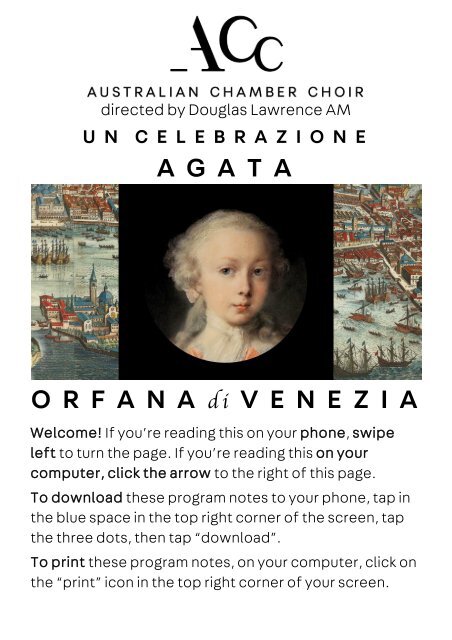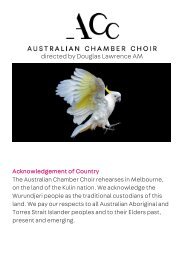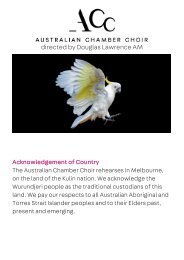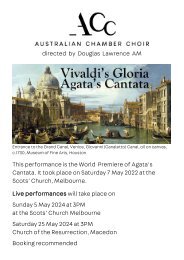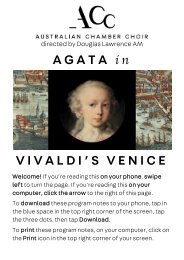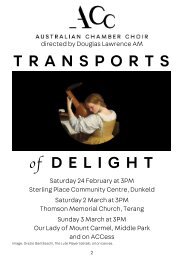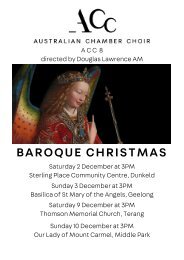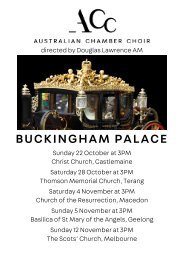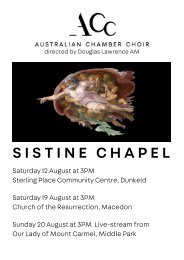Agata, Orfana di Venezia
Detailed program notes, with texts, translations, historical background and artists' names.
Detailed program notes, with texts, translations, historical background and artists' names.
Create successful ePaper yourself
Turn your PDF publications into a flip-book with our unique Google optimized e-Paper software.
<strong>di</strong>rected by Douglas Lawrence AM<br />
U N C E L E B R A Z I O N E<br />
A G A T A<br />
O R F A N A <strong>di</strong> V E N E Z I A<br />
Welcome! If you’re rea<strong>di</strong>ng this on your phone, swipe<br />
left to turn the page. If you’re rea<strong>di</strong>ng this on your<br />
computer, click the arrow to the right of this page.<br />
To download these program notes to your phone, tap in<br />
the blue space in the top right corner of the screen, tap<br />
the three dots, then tap “download”.<br />
To print these program notes, on your computer, click on<br />
the “print” icon in the top right corner of your screen.
AGATA’s CANTATA performances<br />
Saturday 23 April 2022<br />
Thomson Memorial Church, Terang, Victoria<br />
Sunday 24 April 2022<br />
St John’s Flinders, Victoria<br />
Saturday 30 April 2022<br />
Church of the Resurrection, Macedon, Victoria<br />
Sunday 1 May 2022<br />
Basilica of St Mary of the Angels, Geelong, Victoria<br />
Saturday 7 May<br />
Scots’ Church, Melbourne, Victoria<br />
Saturday 13 April 2024<br />
St Andrew’s Church, Hamilton, Victoria<br />
Sunday 21 April 2024<br />
Basilica of St Mary of the Angels, Geelong, Victoria<br />
Sunday 5 May 2024<br />
The Scots’ Church, Melbourne, Victoria<br />
Saturday 25 May 2024<br />
Church of the Resurrection, Macedon, Victoria<br />
Tuesday 16 July<br />
Sala Grande, Palazzo Pisani, Venice<br />
ON DEMAND on ACCess<br />
https://access.auschoir.org/#/item/81064<br />
Watch free of charge with the <strong>di</strong>scount code, IwasTHERE
INTRODUCTION<br />
It is rare that a piece of music written in Europe is<br />
premiered in Australia. But this is the case with <strong>Agata</strong>’s<br />
Cantata. Thanks to the Biblioteca Benedetto Marcello,<br />
the manuscripts of this work have been safely preserved,<br />
so that the work can now be heard by modern au<strong>di</strong>ences.<br />
<strong>Agata</strong>, born without the fingers of her left hand, and<br />
abandoned to the Ospedale della Pietà, would likely not<br />
have received any significant recognition for her<br />
compositions during her lifetime.<br />
This evening, we celebrate <strong>Agata</strong>. She can now add to her<br />
list of achievements ten performances of her Cantata,<br />
her first ra<strong>di</strong>o broadcast (on Australia’s ABC Ra<strong>di</strong>o<br />
National), her first commercial CD recor<strong>di</strong>ng and her first<br />
performance in Venice after a silence of some 300 years.<br />
<strong>Agata</strong>’s Cantata, written for the all-female orchestra of<br />
the Pietà, made famous by Antonio Vival<strong>di</strong>, is heard on<br />
this evening’s program as part of a celebration of<br />
Venetian music from the 17 th and 18 th centuries.<br />
Elizabeth Anderson<br />
“the Australian Chamber Choir has revealed a composer<br />
who combined technical rigour with expressive warmth”.<br />
– The Age, Melbourne, 7 May 2022
Agatha’s First Recor<strong>di</strong>ng<br />
Keys to Heaven, available today<br />
on CD, includes <strong>Agata</strong>’s Cantata,<br />
Ecce nunc, Palestrina’s Tu es<br />
Petrus and Missa Aeterna Christi<br />
Munera, Allegri’s Miserere and<br />
Christus resurgens.<br />
Click here to browse CDs.<br />
Programma<br />
CLAUDIO MERULO (1533–1604)<br />
Gloria, dalla Missa Cara la vita mia, <strong>Venezia</strong>, 1609<br />
CLAUDIO MONTEVERDI (1567–1643) Lauda Jerusalem,<br />
<strong>Venezia</strong>, 1651<br />
AGATA della Pietà (1712–69) La Cantata, Ecce nunc,<br />
<strong>Venezia</strong>, c.1744<br />
Cover illustration: Matthäus Merian (b. Basel, 1539, d.<br />
Schwalbach, 1650), <strong>Venezia</strong> (1636), engraving, detail<br />
Rosalba Carriera (b. 1675, <strong>Venezia</strong>, d. 1757, <strong>Venezia</strong>),<br />
Young Lady of the Le Blond Family (c.1730), pastel on<br />
paper, Galleria dell’Accademia, <strong>Venezia</strong>
GLORIA DALLA MESSA CARA LA VITA MIA<br />
Clau<strong>di</strong>o Merulo<br />
Born in Correggio, Italy, 8 April 1533; <strong>di</strong>ed in Parma, 4 May<br />
1604.<br />
Any history of early instrumental music will note Clau<strong>di</strong>o<br />
Merulo’s copious and virtuosic enrichments of the<br />
keyboard repertoire. He issued five collections of organ<br />
pieces; the first dates from 1567, the last from the year of<br />
his death. All five reflected and augmented his fame as<br />
the greatest Italian organist of his epoch, employed first<br />
at Venice (where his colleagues included both Andrea<br />
and Giovanni Gabrieli), latterly at Parma. The fact that<br />
Merulo also wrote choral music is much less well known.<br />
Indeed, this posthumously published (1609) Mass setting<br />
might well have received its first performance on<br />
Australian soil thanks to the ACC. It belongs to the<br />
Renaissance genre which scholars refer to as the ‘parody<br />
Mass’: a classification unconnected with any satirical<br />
intent, that simply means a Mass that alludes to a preexisting<br />
work, often one by someone else. Merulo used<br />
as the Mass’s thematic basis Cara la vita mia, the secular<br />
madrigal from the pen of Giaches de Wert. While the<br />
Council of Trent (1545-1563) had actively <strong>di</strong>scouraged the<br />
quotation of profane melo<strong>di</strong>c sources in Catholicism’s<br />
liturgical writing, Merulo – along with, let it be said,<br />
several other composers of his time – acted as if no such<br />
<strong>di</strong>scouragement had ever been voiced.
MERULO<br />
Gloria in excelsis Deo<br />
et in terra pax hominibus<br />
bonae voluntatis.<br />
Laudamus te,<br />
bene<strong>di</strong>cimus te,<br />
adoramus te,<br />
glorificamus te,<br />
gratias agimus tibi propter<br />
magnam gloriam tuam,<br />
Domine Deus, Rex caelestis,<br />
Deus Pater omnipotens.<br />
Domine Fili unigenite,<br />
Jesu Christe, Domine Deus,<br />
Agnus Dei,<br />
Filius Patris,<br />
qui tollis peccata mun<strong>di</strong>,<br />
miserere nobis;<br />
qui tollis peccata mun<strong>di</strong>,<br />
suscipe deprecationem<br />
nostram.<br />
Qui sedes ad dexteram<br />
Patris, miserere nobis.<br />
Quoniam tu solus Sanctus,<br />
tu solus Dominus,<br />
tu solus Altissimus,<br />
Jesu Christe, cum Sancto<br />
Spiritu: in gloria Dei<br />
Patris. Amen.<br />
Gloria a Dio nell'alto dei<br />
cieli e pace in terra agli<br />
uomini <strong>di</strong> buona volontà.<br />
Noi ti lo<strong>di</strong>amo,<br />
ti bene<strong>di</strong>ciamo,<br />
ti adoriamo,<br />
ti glorifichiamo,<br />
ti ren<strong>di</strong>amo grazie per la tua<br />
gloria immensa,<br />
Signore Dio, Re del cielo,<br />
Dio Padre onnipotente.<br />
Signore, Figlio unigenito,<br />
Gesù Cristo, Signore Dio,<br />
Agnello <strong>di</strong> Dio,<br />
Figlio del Padre, tu che<br />
togli i peccati del mondo,<br />
abbi pietà <strong>di</strong> noi ; tu che<br />
togli i peccati del mondo,<br />
accogli la nostra<br />
supplica ;<br />
tu che sie<strong>di</strong> alla destra del<br />
Padre, abbi pietà <strong>di</strong> noi.<br />
Perchè tu solo il Santo,<br />
tu solo il Signore,<br />
tu solo l'Altissimo,<br />
Gesù Cristo con lo Spirito<br />
Santo nella gloria <strong>di</strong> Dio<br />
Padre. Amen.
LAUDA JERUSALEM Clau<strong>di</strong>o Montever<strong>di</strong><br />
Baptised in Cremona, Italy, 15 May 1567; <strong>di</strong>ed in Venice, 29<br />
November 1643.<br />
Two <strong>di</strong>fferent Montever<strong>di</strong> works to these particular<br />
words – from Psalm 147 – survive. Of these, the betterknown<br />
one is the one which the composer included in his<br />
celebrated 1610 Vespers. The lesser-known one is the<br />
present one, taken from a collection entitled Messa a<br />
quattro voci et salmi concertati, which Montever<strong>di</strong><br />
neither supervised nor beheld. This collection first<br />
appeared only in 1650, when he had been seven years<br />
dead. (Until something like a modern mass market for<br />
published music arose with Haydn’s European fame in<br />
the late eighteenth century, nearly all the greatest<br />
composers left more pieces behind them in manuscript<br />
than they ever had hopes of seeing in print. Montever<strong>di</strong>,<br />
in this regard, fared better with publishers than most.<br />
Couperin, a hundred years after Montever<strong>di</strong>, fared better<br />
still.) The Lauda Jerusalem setting in today’s concert<br />
minimises the boisterous antiphony of the 1610 version,<br />
and comes somewhat closer to Montever<strong>di</strong>’s<br />
predecessors in the soli<strong>di</strong>ty of its counterpoint.<br />
Nevertheless, the imperious dramatic gesture of<br />
sonorous syllabic chords beginning at the words Gloria<br />
Patri confirms – not for the first time in Montever<strong>di</strong>’s<br />
liturgical output – that while you could take the man out<br />
of the theatre, you could never take the theatre out of the<br />
man.
MONTEVERDI<br />
Lauda Jerusalem<br />
Dominum;<br />
lauda Deum tuum, Sion.<br />
Quoniam confortavit seras<br />
portarum tuarum;<br />
bene<strong>di</strong>xit filiis tuis<br />
in te. Qui posuit fines tuos<br />
pacem,<br />
et a<strong>di</strong>pe frumenti satiat te.<br />
Qui emittit eloquium suum<br />
terræ:<br />
velociter currit sermo<br />
ejus.<br />
Qui dat nivem sicut lanam;<br />
nebulam sicut cinerem<br />
spargit.<br />
Mittit crystallum suam<br />
sicut buccellas:<br />
ante faciem frigoris ejus<br />
quis sustinebit?<br />
Emittet verbum suum, et<br />
liquefaciet ea;<br />
flabit spiritus ejus, et<br />
fluent aquæ.<br />
Qui annuntiat verbum<br />
suum Jacob,<br />
Loda il Signore, o<br />
Gerusalemme,<br />
loda il tuo Dio, o Sion,<br />
perché ha rinforzato le<br />
sbarre delle tue porte.<br />
Ha benedetto i tuoi figli<br />
dentro <strong>di</strong> te, ha dato la<br />
pace ai tuoi confini<br />
e ti sazia col fiore del<br />
frumento.<br />
Egli manda<br />
sulla terra la sua parola,<br />
il suo messaggio corre<br />
veloce;<br />
egli dà neve come lana,<br />
sparge nebbia come<br />
cenere,<br />
manda Il ghiaccio come<br />
sue briciole,<br />
chi resisterà <strong>di</strong> fronte al<br />
suo gelo?<br />
Egli manda la sua parola e<br />
lo scioglie,<br />
il suo spirito soffia e le<br />
acque scorrono.<br />
Egli annunzia la sua parola a<br />
Giacobbe,
MONTEVERDI<br />
justitias et ju<strong>di</strong>cia sua<br />
Israël.<br />
Non fecit taliter omni<br />
nationi,<br />
et ju<strong>di</strong>cia sua non<br />
manifestavit eis.<br />
Gloria Patri, et Filio, et<br />
Spiritui Sancto:<br />
Sicut erat in principio, et<br />
nunc et semper, in saecula<br />
saeculorum. Amen.<br />
i suoi statuti e le sue leggi a<br />
Israele.<br />
Egli non si è comportato<br />
allo stesso modo<br />
con tutte le nazioni<br />
e non ha manifestato loro<br />
le sue leggi.<br />
Gloria al Padre e al Figlio e<br />
lo Spirito Santo<br />
come era nel principio e<br />
ora e sempre e nei secoli<br />
dei secoli. Amen.<br />
https://lyricstranslate.com/it/rv-<br />
609-lauda-jerusalem-rv-609-loda-ilsignore-o.html<br />
ECCE NUNC <strong>Agata</strong> della Pieta<br />
Born probably in Venice, 24 March 1712; <strong>di</strong>ed in Venice, 17<br />
October 1769<br />
When the Australian Chamber Choir premiered this work<br />
on 23 April 2022 in the Victorian town of Terang, the<br />
au<strong>di</strong>ence witnessed the performance of a piece of music<br />
that had not been heard at least since <strong>Agata</strong>’s death in<br />
1769. This is to date the only surviving work composed by<br />
an orphan educated in one of the music schools of the<br />
Venetian ospedali maggiori.
AGATA<br />
Elizabeth Anderson explains the feats of musicological<br />
sleuthing that enabled her to revive the six-movement<br />
Ecce Nunc, which incorporates words taken from Psalm<br />
134 (Psalm 133 in the Latin Vulgate translation):<br />
I’ve always been fascinated by the idea that<br />
female orphans in eighteenth-century Venice<br />
were given an excellent education in music. At the<br />
Ospedale della Pietà, Antonio Vival<strong>di</strong> <strong>di</strong>rected the<br />
first all-women’s orchestra, which became<br />
famous throughout Europe for the high quality of<br />
its performances. I first learned about this during<br />
a high school music appreciation class in the town<br />
of Launceston, on the island of Tasmania, where I<br />
grew up. My imagination was ignited, and my mind<br />
imme<strong>di</strong>ately left the classroom: on an island on<br />
the other side of the world, girls were given a<br />
rigorous musical education and performed in a<br />
professional choir and orchestra under the baton<br />
of one of the world’s most famous composers. I<br />
pondered the idea that there might be<br />
compositions by the orphan girls of the Pietà to be<br />
re<strong>di</strong>scovered.<br />
Some four decades later, when my husband,<br />
Douglas Lawrence and I decided on a<br />
performance of Vival<strong>di</strong>’s Gloria for the ACC’s<br />
2022 season, the search began. From articles<br />
about music education in the Venetian ospedali
AGATA<br />
maggiori, I found the names of three orphan<br />
composers of the Pietà – <strong>Agata</strong>, Michielina and<br />
Santa.<br />
Pio Ospedale della Pietà, before the early 18 th century construction of the facade of the<br />
adjacent church (detail), anon, 1686, Venice, private collection<br />
My search narrowed to the Biblioteca Benedetto<br />
Marcello in Venice: I’m grateful to Consultant<br />
Librarian, Silvia Urbani, who gave me advice and<br />
furnished me with copies of the surviving<br />
manuscript parts. You can imagine my excitement<br />
when, the day after requesting the manuscripts<br />
for <strong>Agata</strong>’s cantata, the set of yellowed images<br />
arrived in my inbox. The set consisted of a<br />
complete first violin part and a complete cello<br />
part, as well as choir parts for alto and bass voice.<br />
The choir parts were for three of the six<br />
movements, with the remaining three movements
AGATA<br />
marked tacet. The three movements in which the<br />
choral singers were silent were solo arias.<br />
“I keyed in the available material for the opening<br />
movement for choir and orchestra to create a<br />
skeletal full score, from which we could assess<br />
the composition and calculate how much work<br />
would be involved in a possible reconstruction.<br />
After an hour’s work, it was clear that we were<br />
dealing with an exciting piece of choral and<br />
orchestral writing similar in style to the music of<br />
Vival<strong>di</strong>. At this point, Douglas Lawrence and I knew<br />
that we had struck gold!<br />
Page one of the first violin part of Agatha della Pietà’s Cantata, Ecce Nunc
AGATA<br />
I’m grateful to our son, Jacob Lawrence, (who<br />
recently completed a Master’s degree<br />
specialising in early music at the Schola Cantorum<br />
in Basel) for his assistance in reviewing the drafts<br />
of my reconstruction.<br />
It is a privilege to ensure that <strong>Agata</strong>, after some<br />
300 years of silence, can receive the recognition<br />
that she deserves.<br />
The composer, whose surname is unknown – the records<br />
identify her purely as ‘<strong>Agata</strong>’ – had been born without<br />
the four fingers of her left hand. She was given up to the<br />
Pietà, probably on the day of her birth, in 1712, via a small<br />
revolving door, known as a scafetta, in the orphanage’s<br />
façade. Admitted to Vival<strong>di</strong>’s famous Coro at the age of<br />
eleven, <strong>Agata</strong> learned singing from Apollonia, also an<br />
orphan of the Pietà, about twenty years her senior. <strong>Agata</strong><br />
soon shone as a star student. Two composers, Andrea<br />
Bernasconi and Giovanni Porta, left manuscripts of<br />
cantatas that specifically identify <strong>Agata</strong> as a soprano<br />
soloist.<br />
<strong>Agata</strong> never married and continued to live at the Pietà,<br />
employed first as a teacher of singing and later also as<br />
the institution’s Priora, or administrator. She is mentioned<br />
in a poem, of unknown authorship, which describes the<br />
Pietà’s musical life. Program notes © Robert James Stove 2021, 2024<br />
Read more about <strong>Agata</strong>’s life at https://www.auschoir.org/who-was-agatha/
AGATA<br />
Soprano, Coro<br />
Ecce nunc bene<strong>di</strong>cite<br />
Dominum,<br />
Soprano<br />
omnes servi Domini:<br />
Qui statis in domo<br />
Domini, in atriis<br />
domus Dei nostri.<br />
Contralto<br />
In noctibus extollite<br />
manus vestras in sancta,<br />
et bene<strong>di</strong>cite Dominum.<br />
Coro<br />
Bene<strong>di</strong>cat te Dominus ex<br />
Sion, qui fecit caelum et<br />
terram.<br />
Duetto – due soprani<br />
Gloria Patri,<br />
et Filio,<br />
et Spiritui Sancto:<br />
Soprano, Coro<br />
Sicut erat in principio,<br />
et nunc et semper,et in<br />
saecula saeculorum.<br />
Ecco, bene<strong>di</strong>te il<br />
Signore,<br />
voi tutti, servi del Signore;<br />
voi che state nella casa del<br />
Signore<br />
durante le notti. Alzate le<br />
mani verso il tempioe<br />
bene<strong>di</strong>te il Signore.<br />
Da Sion ti bene<strong>di</strong>ca il<br />
Signore,che ha fatto cielo<br />
e terra.<br />
Gloria al Padre<br />
e al Figlio<br />
e lo Spirito Santo<br />
come era nel principio e<br />
ora e sempre e nei secoli<br />
dei secoli. Amen.<br />
https://www.biblegateway.<br />
com/passage/?search=Salmi<br />
+134&version=CEI
You have been listening to the singers of the<br />
Australian Chamber Choir<br />
SOPRANO<br />
Victoria Brown<br />
Alex Hedt<br />
Kristina Lang (solo sop.2)<br />
Katherine Lieschke<br />
Kate McBride (solo sop.1)<br />
Jennifer Wilson-Richter<br />
ALTO<br />
Elizabeth Anderson<br />
Neda Bizzarri (solista)<br />
Melissa Lee<br />
Katie Renner<br />
TENOR<br />
Matthew Bennett<br />
Will Carr<br />
Joshua Lucena<br />
Sam Rowe<br />
BASS<br />
Thomas Drent<br />
Kieran Macfarlane<br />
Tom Reid<br />
Lucas Wilson-Richter<br />
and the instrumentalists of the Conservatorio Benedetto<br />
Marcello<br />
VIOLINO I<br />
VIOLONCELLO<br />
Nome e Cognome<br />
VIOLINO II<br />
Nome e Cognome<br />
VIOLA<br />
Nome e Cognome<br />
Nome e Cognome<br />
VIOLONE<br />
Nome e Cognome<br />
CLAVICEMBALO<br />
Nome e Cognome


